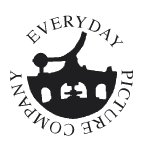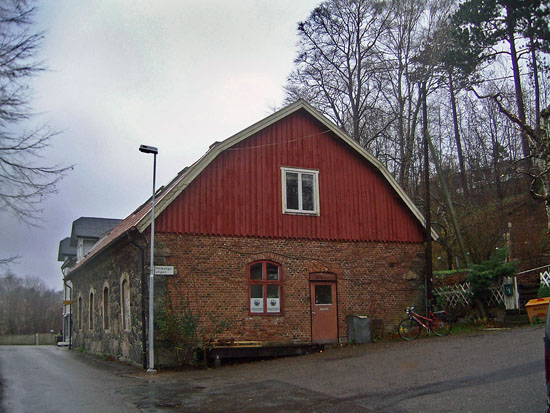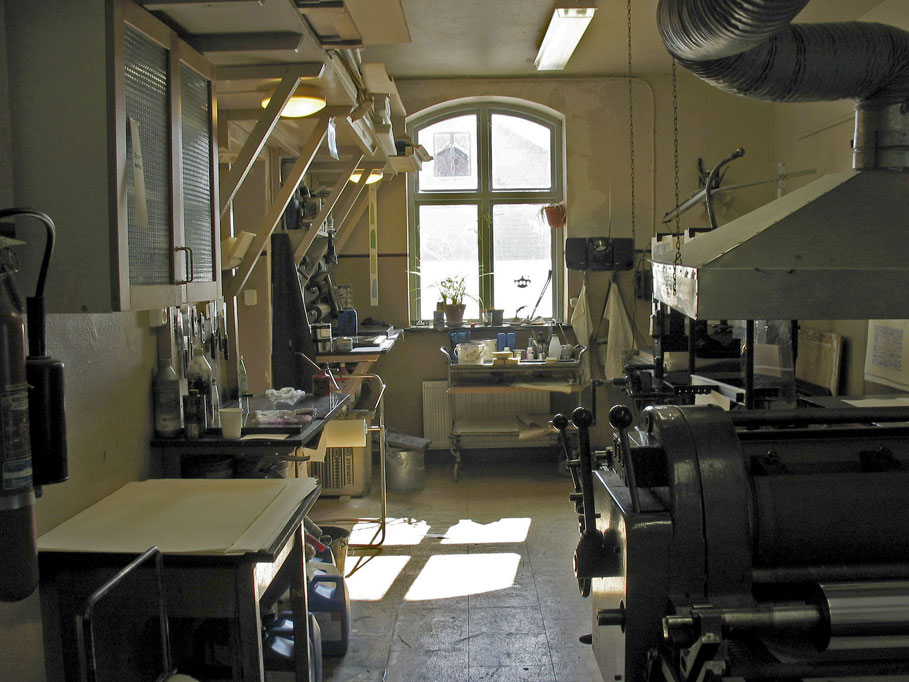 |
JIM BERGGREN
NINA BONDESON JAN BRINGEVIK
KJELL-ÅKE GERINDER ROLF
GUSTAFSSON SVENROBERT LUNDQVIST NILS-ERIK MATTSSON ULLA MAGNUSSON MONA NIKLASSON Everyday Picture Company Fine Print Studio Norra Forsåkersgatan 29 431 63 Mölndal Sweden +4631-87 12 18 info@vardagsbilder.se |
 |
 |
| Our work
shop in Mölndal upholds a far-fetched, but still, connection to
Senefelder. In our liquid modernity it is nice to discover connections. They give good support for anyone, to maintain the kind of uncertainty (osäkerhet) that helps you avoid a spineless (ryggradslös, velig) adaptability (anpassningsförmåga). We are all much too vulnerable (sårbara) to do without that opportunity. This special connection, has a span from 1818 until now and further on, into the future. That´s quite an extensive span to take into considerration these days, when inovations older than five years are sometimes regarded as useless. In 1818 Alois Senefelder wrote his ”Vollständiges Lehrbuch der Steindruckerei” In which he describes all his experiences of his own invention: The Chemical Plane Print; the lithography, or stone print. Later on, grained zinc plates were used instead of stones, and later yet, aluminum tintypes that were to be printed in off set presses. But the printing principle rests steadily in Senefelders original idea. In his time, the chemical adventure took place on plane limestones that he had found outside of Munich, where he lived. He invented and developed this method, as far as he possibly could, and left it to us as a heritage (arv). I´m very sure that he would have taken great interest in the possibilities that our computerized time has connected to his invention. At about the same time, it could even be the very same year, 1818, when Senefelder wrote his book on lithography, a house was built in Mölndal, just south of Gothenburg. A brick house with big granite stones in the ground. It´s a house that after 160 years, and a great many different activities, gave room to a lithographic work shop in wich Senefelders Chemical Plane Print continued its course through photo mechanical sollutions into the digital era. Then,.. in 1978,.. ten artists graduated from Valand school of Art and started a lithographic work-shop and named it Bolaget Vardagsbilder (Everyday Picture Company). Even if the group have changed over the years; with members leaving, others joining, the name and the work have been stable and perfectible (utvecklingsbar) to both content and meaning. In these turbulent times we live in, it is the every day life that saves us. Its modest and incorruptible routines help us to balance, so that we don´t have to stumble around in life, unable to reflect on how and why. A Company with ”Everyday Pictures” is, in connection to that, of course indispensable..... |
The house
itself is a two-storey building with the print shop down
stairs and and a studio on top. It has one smaller stone press from the
19th century and a big Steinmesse & Stollberg offset press
from
1956. The workshop has, in the last decade, been upgraded with pre
press possibilities on an elementary basis. You could say that the situation resembles (liknar) Senefelders: as he did... we too... want to gain access to printing facilities on our own terms. The equipment needed is of course expensive, but still within the reach for a smaller artist group like ours. Standard soft ware like Photoshop, Indesign etc, laser printers that provide size up to A3 and an ink printer that is getting close to big formats will get you a long way. One could write a special chapter about the scanner, the importance of wich cannot be overestimated! It lodges the capacity to convert any printmaker into an euphoric, digital filing clerk. It helps us to process our pictures through the digital possibilities, and then, by using four-colour technique in preparing the printing, we can link different printing projects together. And over the internet we can work with friends and colleagues anywhere in the world; it has really changed our ways of working. But in the end, all these possibilities are still at their best in collaboration with the old standards, when it comes to the actual Printing. The old, lasting papers and inks that balance the volatility (lättrörlighet, flyktighet, osäkerhet, fluktuation, volatilitet) of computers. In this small-scale print shop situation, where you can combine 19th century techniques with the latest affordable upgrades, you get a different stature (kaliber) on both tradition and renewal. The old house looks the same on the outside as it did almost 200 years ago, but it is not as far away in the world as it was then. It stands as solid as ever, on its´granite ground, as does our need to visualize and ponder over what it is to live this life. And that´s what we do, images that tell about our own experiences, about everyday life, and death, and the world we live in. This work shop has become a place where the inherited (nedärvda) knowledge from Alois Senefelder, is part of a courtship (parningslek, uppvaktning) with newest digital techniques. It´s very handy. It transforms time into a room and it puts us in any middle of the world. (Alois Senefelder, Munich, 1771 – 1834). |
Contact: Jim Berggren +46708-27 21 65
BOLAGET
VARDAGSBILDER KONSTGRAFISK VERKSTAD
* EVERY DAY PICTURE COMPANY